The document discusses various performance management systems (PMS) and their influence on employee performance. It reviews several PMS approaches, including management by objectives, balanced scorecard, total quality management, and productivity measurement and enhancement systems. The literature suggests that an effective PMS should align individual goals with organizational objectives, provide continuous feedback, and involve employees in the design process. When implemented properly with the right design that considers both internal and external factors, PMS can help improve overall organizational performance by motivating employees and linking their work to strategic goals.
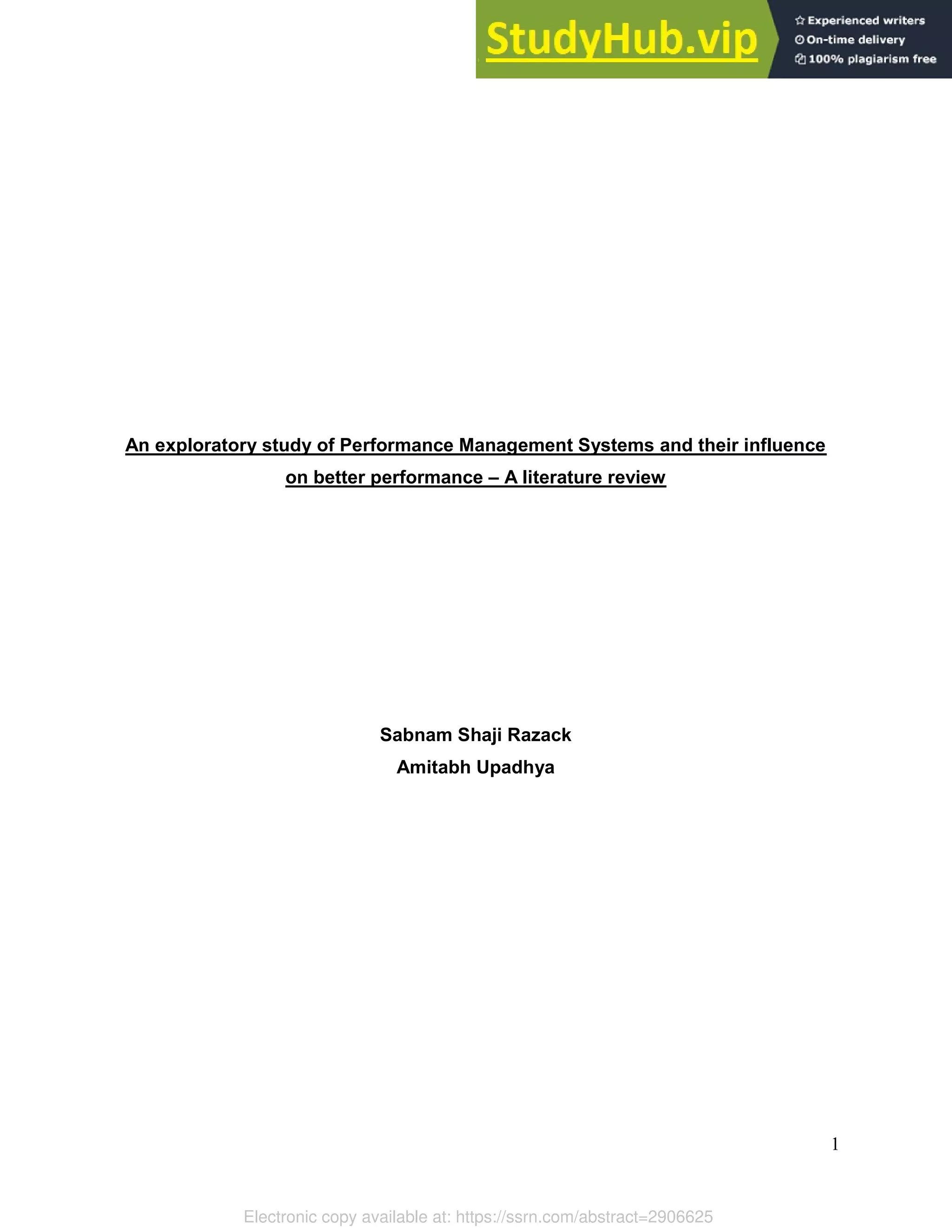
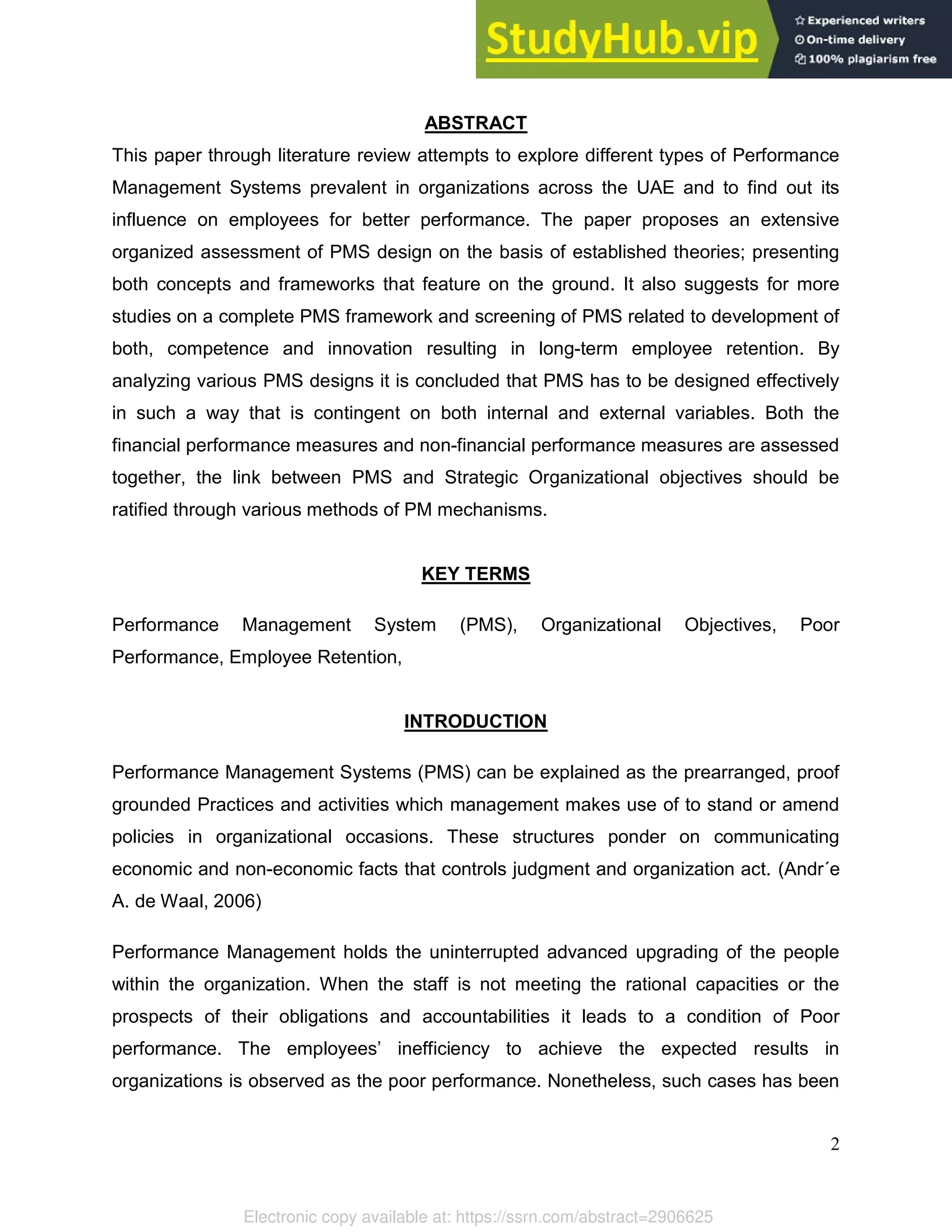
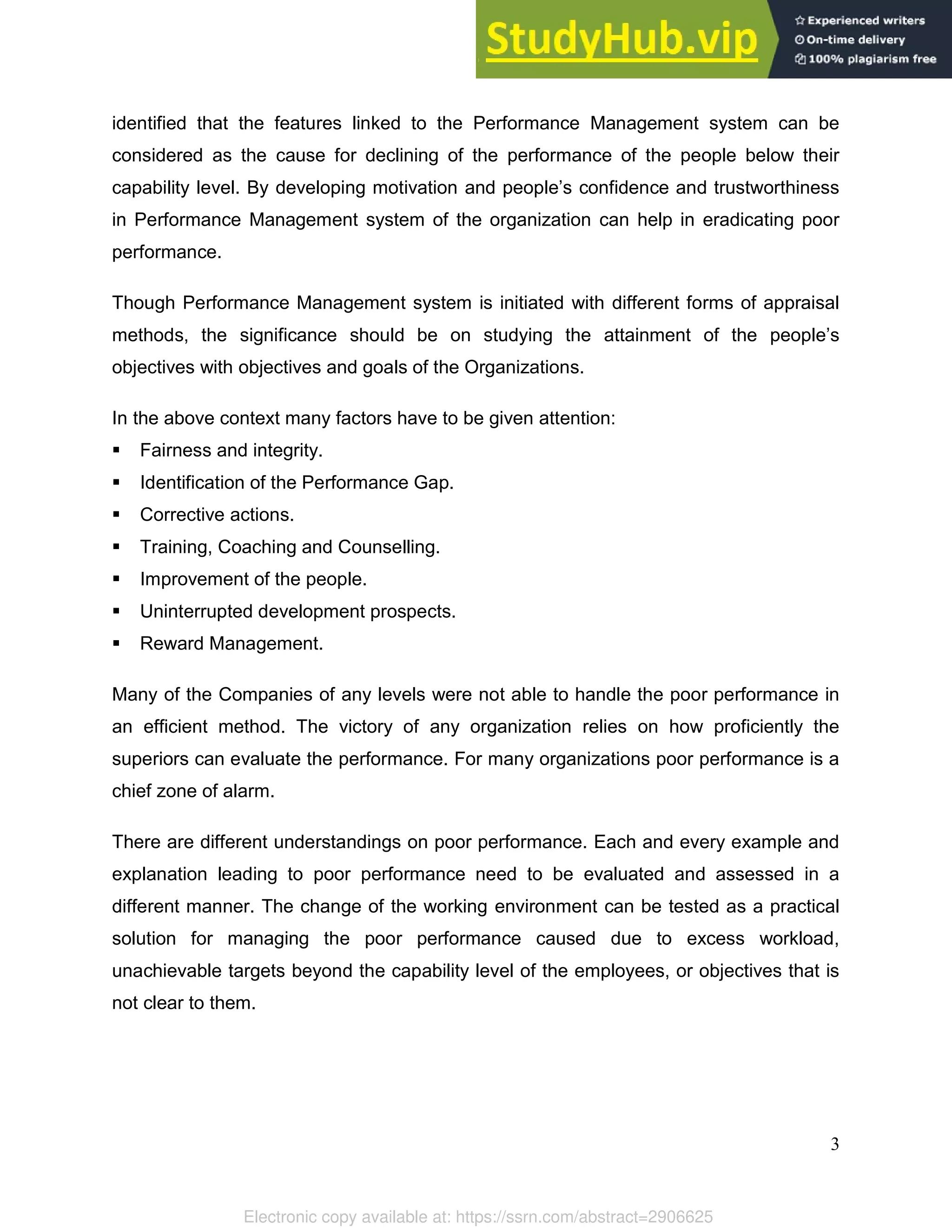
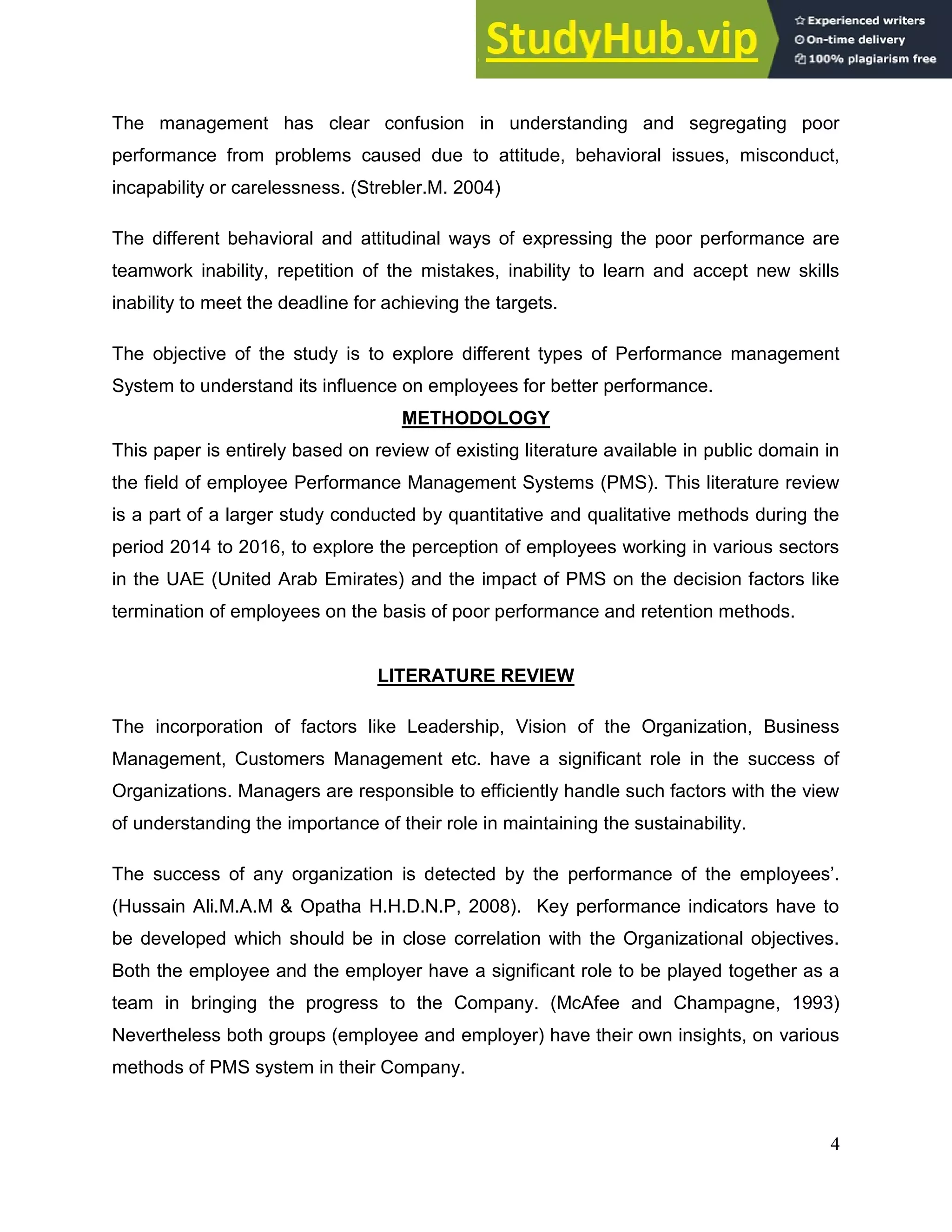
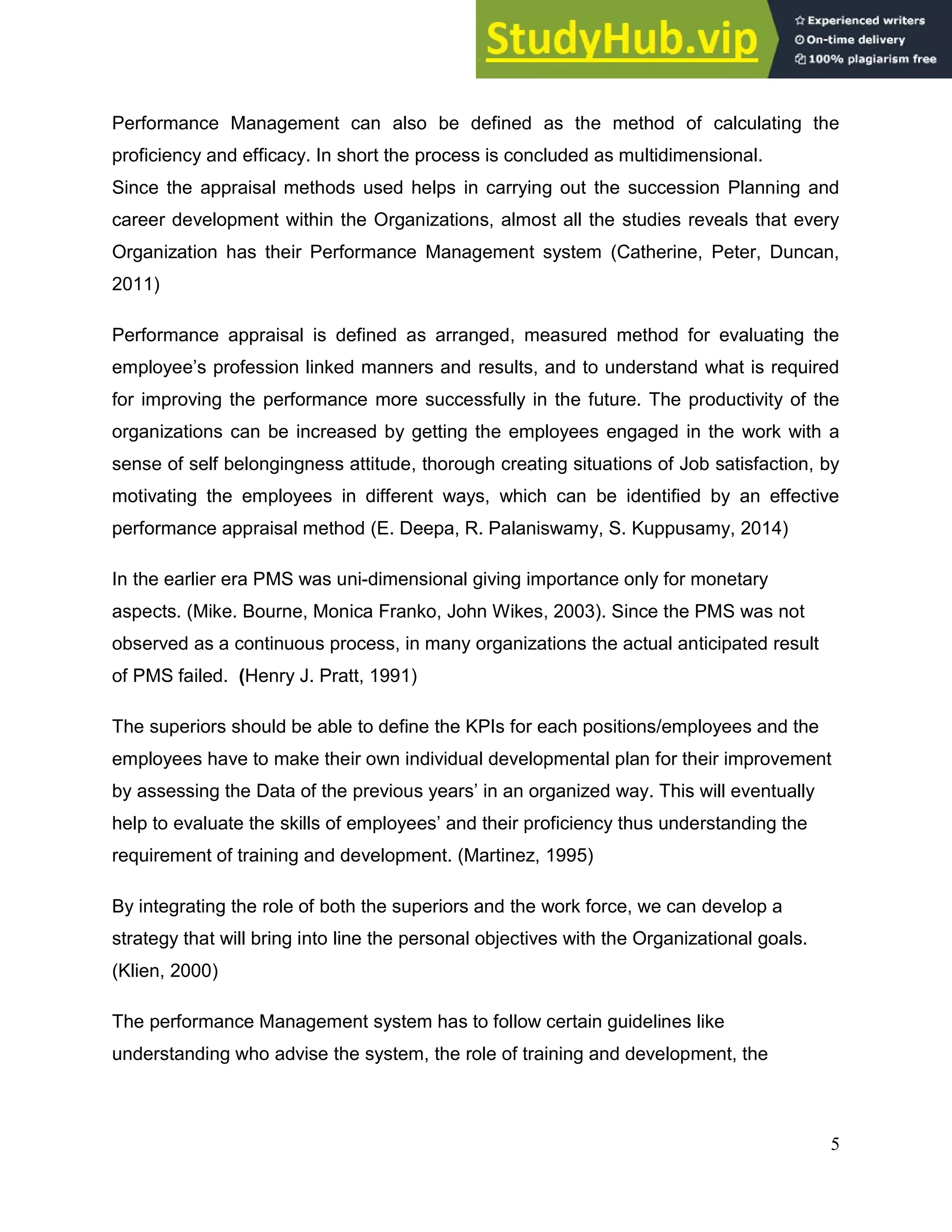

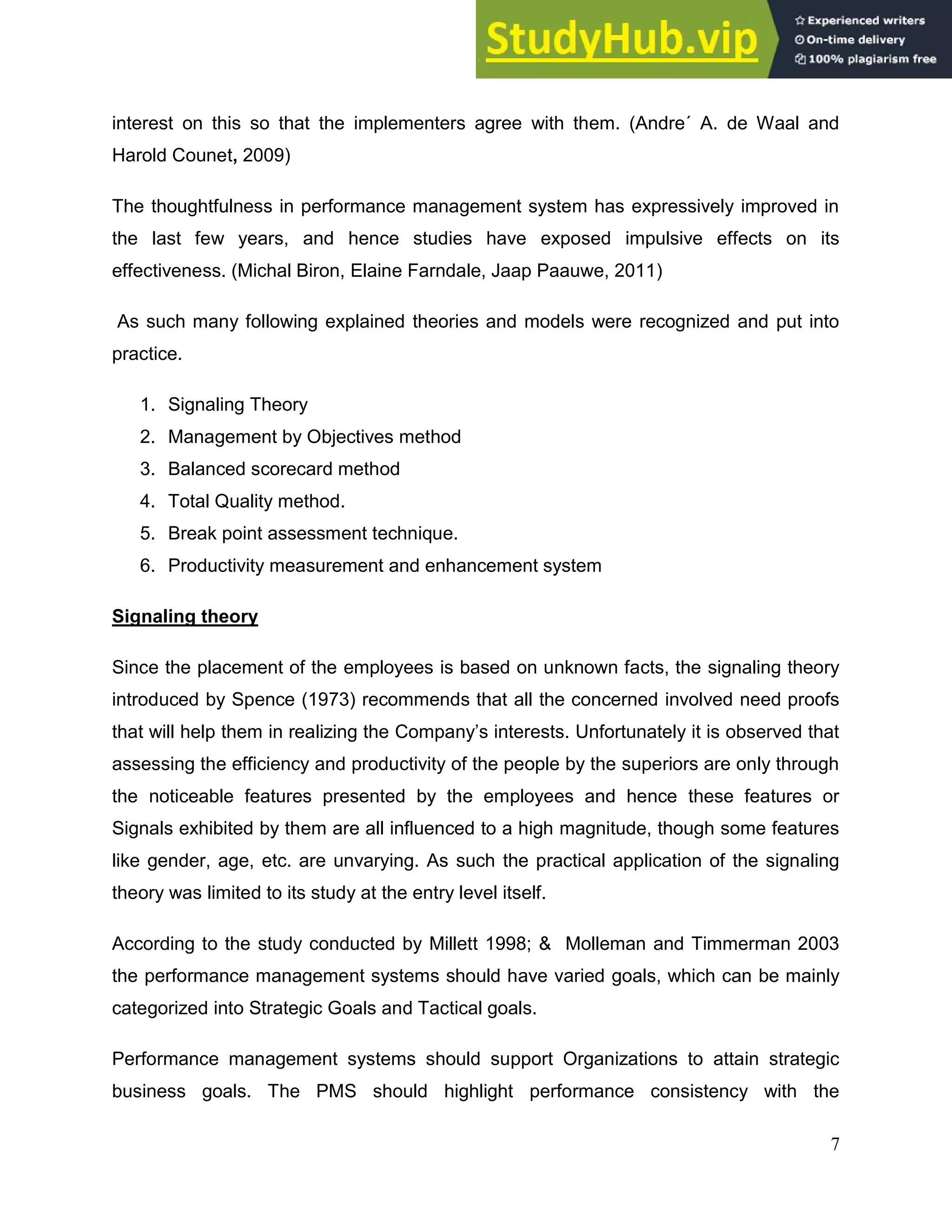
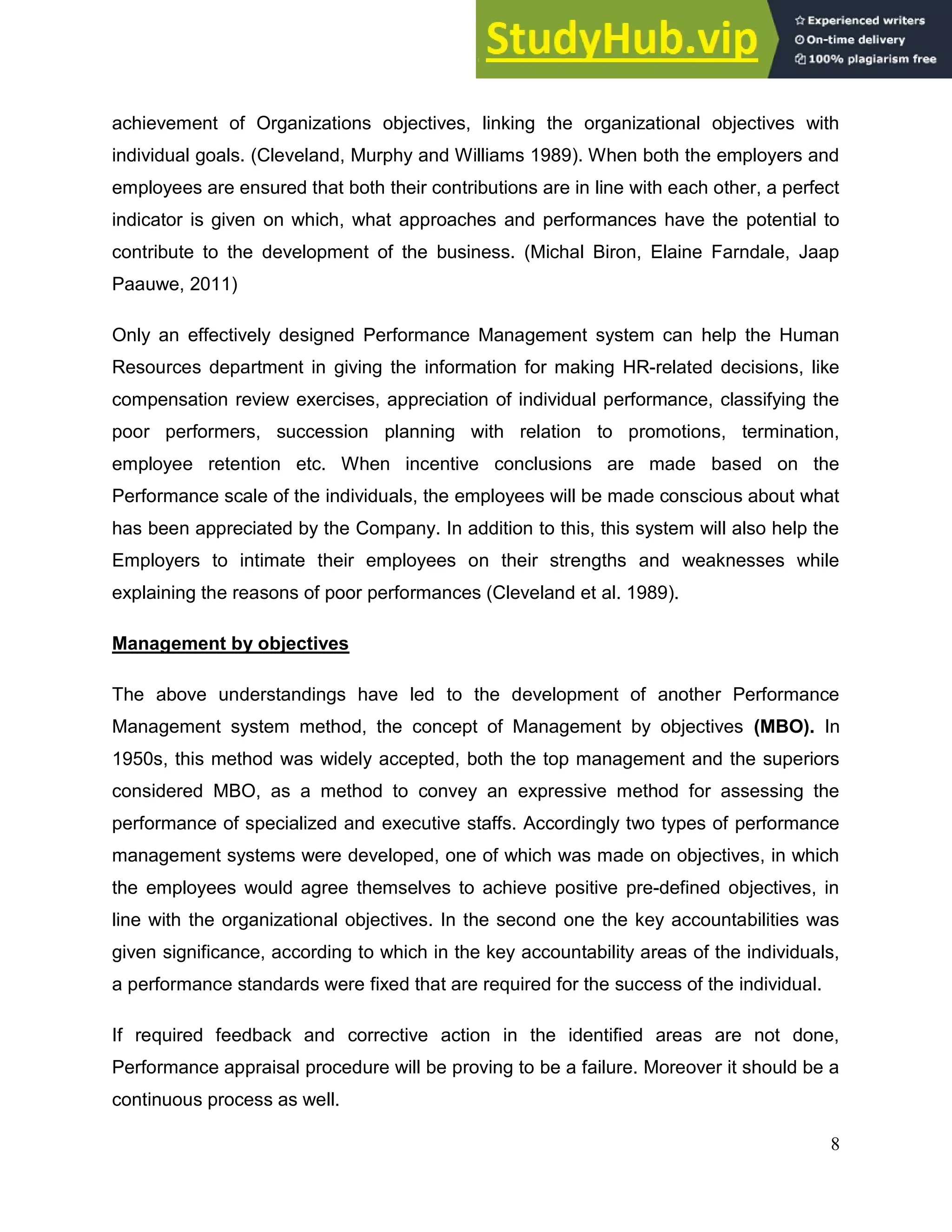
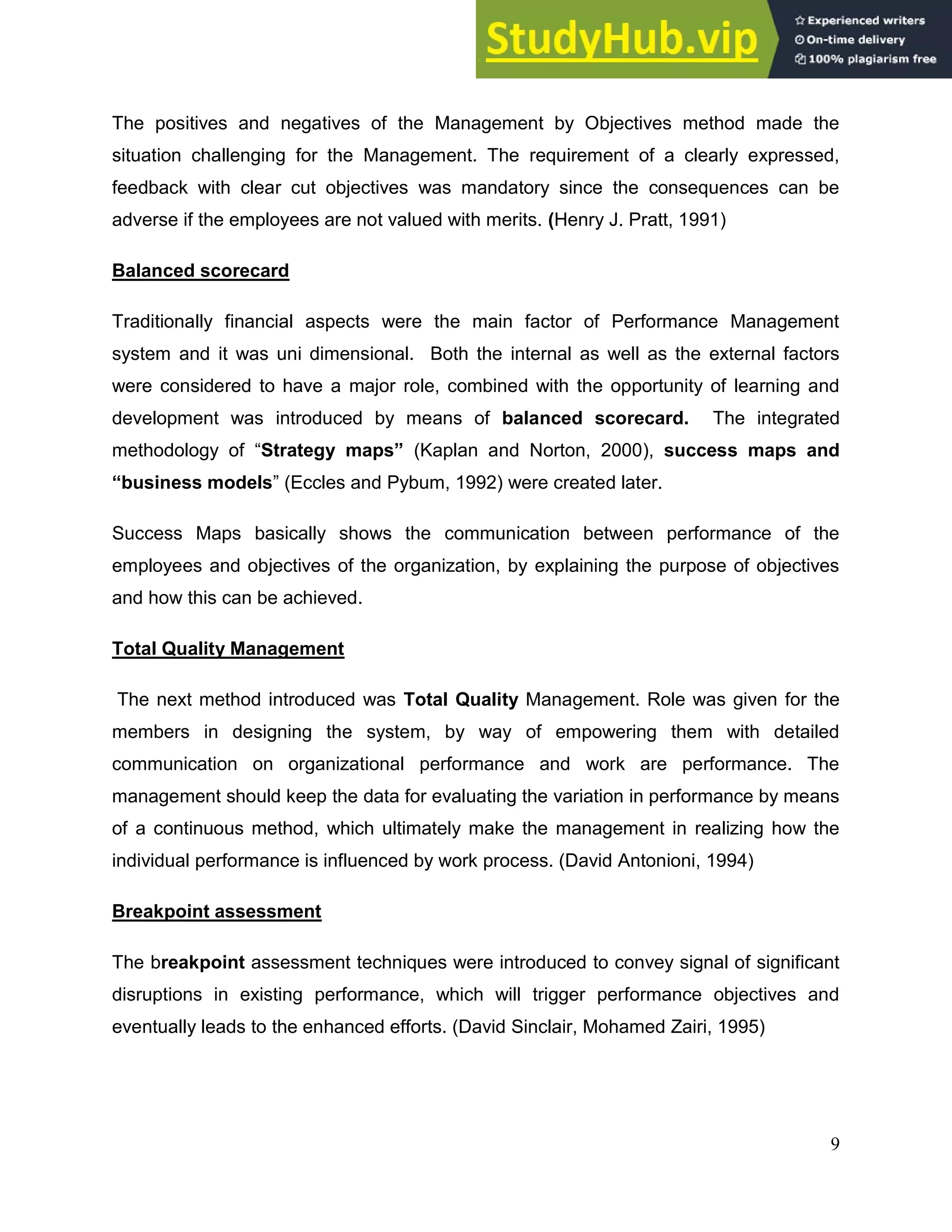
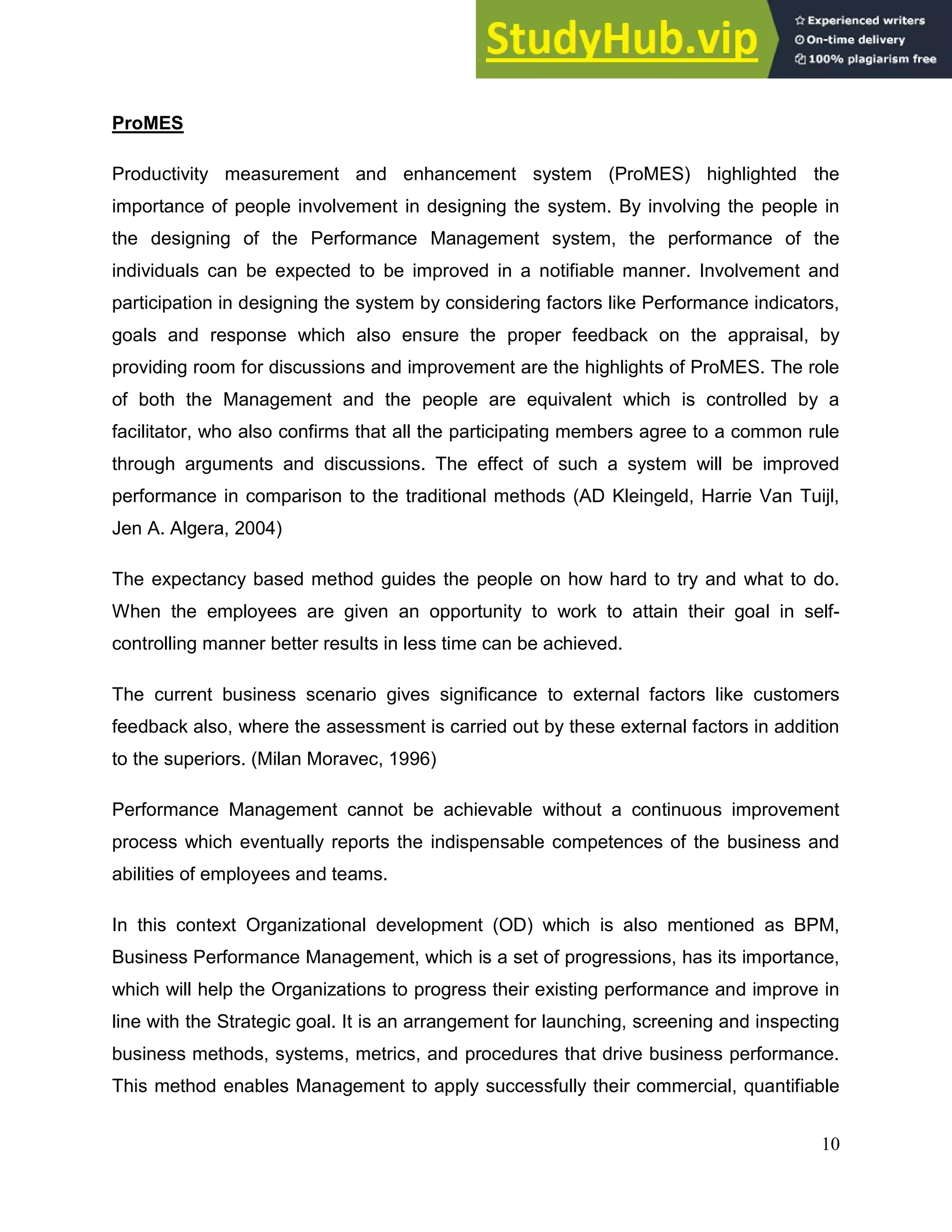

![12
Need to ensure that the Organizational objectives are informed to all and made
aware the expectations from them, and what is their status.
Ensure timely and proper performance feedback provided.
Rewards and appreciation methods to be implemented.
Encourage improvement and learning process.
The literature concludes that for the Organization to achieve its goals an Effective
performance Management system should to be developed, which takes into
consideration all the factors mentioned above.
SCOPE FOR FURTHER RESEARCH
There is ample scope for further researches in these topics to understand how these
Performance Management systems can ascertain the relationship between employee
retention, employee termination and poor performance. The Performance Management
system prevailing in different Organizations by specifically selecting a geographical area
or a specific type of industry, however, can be conducted with the help of a survey by
using both Quantitative and Qualitative analysis methods. This will help to understand
the perception of the employees in the type of Performance Management systems in
their organizations, and thereby methodologies can be established to make the system
more employees friendly so that overall Organizational objectives can be attained by a
participative mechanism.
REFERENCES
1. Antonioni, D. (1994). Improve the Performance Management process before
discontinuing performance appraisal. Compensation and Benefits Review,
May/June, pp. 29-37.
2. Biron, M., Farndale, E. and Paauwe, J (2011). Performance Management
effectiveness: Lessons learned from world-leading firms. International Journal of
Human Resource management, [online] Volume 22(6), pp 1294-1311336.
Available at: http://www.informaworld.com [6 June. 2015]](https://image.slidesharecdn.com/anexploratorystudyofperformancemanagementsystemsandtheirinfluenceonbetterperformance-aliteraturerevi-230805174347-0d24651d/75/An-Exploratory-Study-Of-Performance-Management-Systems-And-Their-Influence-On-Better-Performance-A-Literature-Review-Sabnam-Shaji-Razack-12-2048.jpg)
![13
3. Bourne, M., Franco, M and Wilkes. (2003). Corporate Performance Management.
Measuring Business Excellence. Vol. 7(3), pp. 15-21.
4. Bruce McAfee, R. and Champagne, P.J. (1993). Performance Management: A
Strategy for improving Employee performance and productivity. Journal of
Managerial Psychology, 8(5), pp.24 – 32.
5. Chubb, C., Reilly, P. and Brown, D. (2011). Performance Management, Literature
review. 1st
ed. [pdf] Brighton, UK: Institute for employment studies, pp. 1-35.
Available at: http://www. http://www.employment-studies.co.uk/ [Accessed 1
November. 2014].
6. Cleveland, J.N., Murphy, K.R and Williams, R.E. (1989). Multiple uses of
Performance appraisal: Prevalence and correlate. Journal of Applied Psychology,
74, pp. 130-135.
7. Cripe, E.J. (1997). Making Performance Management a positive experience.
ACA news, 40(10), pp. 22-26.
8. De Waal, A. and Coevert, H. (2007). The effect of Performance Management on
the organizational results of a bank. International Journal of Productivity and
Performance management, 56(5/6), pp. 397-416.
9. De Waal, A. and Counet, H. (2009). Lessons learned from Performance
Management systems implementations. International Journal of Productivity and
Performance Management, 58(4), pp. 367-390.
10.De Waal, A. (2006). The Role of Behavioral Factors and National Cultures in
Creating Effective Performance Management System. Systemic Practice and
Action Research, 19(1), p. 63-79.
11.Eccles, R.G. and Pybum, P.J. (1992). Creating a comprehensive system to
measure performance. Management Accounting [US], October, pp. 41-44.
12.E.Deepa., Dr.R.Palaniswamy. and Dr.S.Kuppusamy. (2014). Effect of
Performance Appraisal System in Organizational Commitment, Job Satisfaction
and Productivity. The Journal Contemporary Management Research 8(1), pp. 72
- 82.](https://image.slidesharecdn.com/anexploratorystudyofperformancemanagementsystemsandtheirinfluenceonbetterperformance-aliteraturerevi-230805174347-0d24651d/75/An-Exploratory-Study-Of-Performance-Management-Systems-And-Their-Influence-On-Better-Performance-A-Literature-Review-Sabnam-Shaji-Razack-13-2048.jpg)
![14
13.Hussain Ali.M.A.M and Opatha H.H.D.N.P, (2008). Performance Appraisal
System and Business Performance: An Empirical Study in Sri Lankan Apparel
Industry, Sri Lankan Journal of Human Resource Management, 2(1), pp. 74–89.
14.Kaplan, R.S., and Norton, D.P. (2000). Having trouble with your strategy? Then
map it. Harvard Business Review, September/October, pp. 167-176.
15.Kleingeld, AD., Tuijl, H.V. and Algera, J.A. (2004). Participation in design of the
performance management systems: a quasi-experimental field study. Journal of
Organizational behavior, [online] Volume 25, pp 831-851. Available at:
http://www.interscience.wiley.com/DOI:10.1002/job.266 [6 June. 2015]
16.Klien, K. (2000). Searching 360 degrees for employee evaluation. Incentives.
170(10), pp. 40-42.
17.Linge, J.H. and Scheiman, W.A. (1996). From the balanced scorecard to
strategic gauches: is measurement worth it. Management Review, 85(3), pp.56-
61.
18.Martinez, M.M. (1995). Evaluation process gets mediocre grades. HR
Magazines, 40(5), pp.14-15.
19.Millet, B. (1998). Performance Management: A strategic Human Resource
function. Human Resource management: Contemporary challenges and future
direction. Eds. K.Parry and D. Smith. Toowoomba: USQ Press, pp. 95-114.
20.Molleman, E., and Timmerman, H. (2003). Performance Management when
innovation and learning become critical Performance Indicators. Personnel
review, 32, pp. 93-113.
21.Moravec, M. (1996). Bringing Performance Management out of the stone age.
Management Review, February, 85(2), p. 38.
22.Neely, A. and Bourne, M. (2000). Why measurement initiatives fail. Measuring
Business Excellence, 4(4), pp.3-6.
23.Pratt, Henry J. (1991). Principles of Effective Performance Management. 1st ed.
[pdf] Prairie Village, US: Arma International. pp. 1-6. Available at:](https://image.slidesharecdn.com/anexploratorystudyofperformancemanagementsystemsandtheirinfluenceonbetterperformance-aliteraturerevi-230805174347-0d24651d/75/An-Exploratory-Study-Of-Performance-Management-Systems-And-Their-Influence-On-Better-Performance-A-Literature-Review-Sabnam-Shaji-Razack-14-2048.jpg)
![15
http://www.proquest.com/products-services/ProQuest-Research-Library.html
[Accessed 6 June. 2015].
24.Simons, R. (2000). Performance Management and control system for
implementing Strategy: Text and Cases, Newyork: Prentice Hall.
25.Sinclair, D and Zairi, M. (1995). Effective process management through
performance measurement Part II - benchmarking total quality-based
performance measurement for best practice. Business Process Re-Engineering
& Management Journal, 1st
edn [ebook]) Bradford, UK: Emerald Group
Publishing, Limited, pp.1-58. Available at:
http://search.proquest.com/docview/220296978?accountid=166567. [Accessed 6
June. 2015].
26.Spence,M. (1973). Job Market signaling. Quarterly Journal of Economics, 87, pp.
355-374.
27.Strebler, M. (2004). Tackling Poor Performance. 1st
ed. [pdf], Brighton,UK:
Institute of Employment Studies. pp. 1-39. Available at: http://www.employment-
studies.co.uk [Accessed 6 June. 2015].](https://image.slidesharecdn.com/anexploratorystudyofperformancemanagementsystemsandtheirinfluenceonbetterperformance-aliteraturerevi-230805174347-0d24651d/75/An-Exploratory-Study-Of-Performance-Management-Systems-And-Their-Influence-On-Better-Performance-A-Literature-Review-Sabnam-Shaji-Razack-15-2048.jpg)